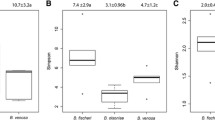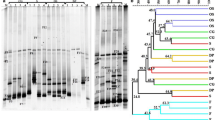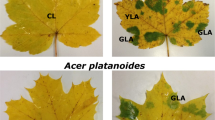Abstract
Studies on the diversity and technological potential of leaf fungal endophytes invariably focus on the dominant fungal species among them. There is hardly any information on the diversity and role of endophytic fungi present in low frequencies (minor species) inside leaves. Hence, we studied the diversity of the minor species of leaf endophytes and speculate on the possible roles such fungi could play in the ecosystem. Mature leaves of twenty-five woody tree species from tropical dry thorn (DT), dry deciduous (DD), and montane evergreen (ME) forests of the Nilgiri Biosphere Reserve, southern India, were screened for the presence of minor species of fungal endophytes (colonization frequency of < 5%). We recorded 47, 35, and 51 minor species in DT, DD, and ME forests, respectively. Species of Aspergillus, Cladosporium, Corynespora, Drechslera, Eurotium, Gliocladium, Lasiodiplodia, Nigrospora, Nodulisporium, Paecilomyces, Penicillium, and Phoma were present in the leaves of trees growing in all the forests studied. Lasiodiplodia spp. were most common among the minor endophytes and could be isolated from 32 tree species from the 3 different forest types. Isolates of Lasiodiplodia spp. produced enzymes including β-glucosidase, cellulase, laccase, pectinase, pectate transeliminase, and protease as well as antifungal metabolites. This study highlights the need to study leaf endophytes exhibiting low frequency of occurrence to know their influence in selecting, constituting, and functioning of the plant microbiome.



Similar content being viewed by others
Data availability
All the generated data were analysed and included with this publication.
Code availability
Not applicable.
References
Arnold AE, Lutzoni F (2007) Diversity and host range of foliar endophytes: are tropical leaves biodiversity hotspots? Ecology 88:541–549
Arnold AE, Maynard Z, Gilbert GS, Coley PD, Kursar TA (2000) Are tropical fungal endophytes hyperdiverse? Ecol Lett 3:267–274
Banerjee S, Schlaeppi K, van der Heijden MGA (2018) Keystone taxa as drivers of microbiome structure and functioning. Nat Rev Microbiol 16:567–576
Boeken B, Shachak, (2006) M Linking community and ecosystem processes: the role of minor species. Ecosystems 9:119–127
Chapla VM, Zeraik ML, Ximenes VF, Zanardi LM, Lopes MN, Cavalheiro AJ, Silva DHS, Young MCM, da Fonseca LM, Bolzani VS, Araújo AR (2014) Bioactive secondary metabolites from Phomopsis sp. an endophytic fungus from Senna spectabilis. Molecules 19:6597–6608
Chen J, Zhang L-C, Xing Y-M, Wang Y-Q, Xing X-K, Zhang D-W, Liang H-Q, Guo S-X (2013) Diversity and taxonomy of endophytic xylariaceous fungi from medicinal plants of Dendrobium (Orchidaceae). PloS ONE 8:e58268
Chitnis VR, Suryanarayanan TS, Nataraja KN, Prasad SR, Oelmüller R, Shaanker RU (2020) Fungal endophyte-mediated crop improvement: the way ahead. Front Plant Sci 11:561007
Christian N, Sedio BE, Florez-Buitrago X, Ramírez-Camejo LA, Rojas EI, Mejía LC, Palmedo S, Rose A, Schroeder JW, Herre EA (2020) Host affinity of endophytic fungi and the potential for reciprocal interactions involving host secondary chemistry. Am J Bot 107:219–228
Coutinho IB, Freire FCO, Lima CS, Lima JS, Gonçalves FJT, Machado AR, Silva AMS, Cardoso JE (2017) Diversity of genus Lasiodiplodia associated with perennial tropical fruit plants in northeastern Brazil. Plant Pathol 66:90–104
Dawson W, Hör J, Egert M, van Kleunen M, Pester M (2017) A small number of low-abundance bacteria dominate plant species-specific responses during rhizosphere colonization. Front Microbiol 8:975. https://doi.org/10.3389/fmicb.2017.00975
de Silva NI, Phillips AJL, Liu J, Lumyong S, Hyde KD (2019) Phylogeny and morphology of Lasiodiplodia species associated with Magnolia forest plants. Sci Rep 9:14355
Ellis MB (1976) More dematiaceous hyphomycetes. Commonwealth Mycological Institute, Kew
Ellis MB, Ellis JP (1988) Microfungi on miscellaneous substrates: an identification handbook. Croom Helm, London
Eng F, Haroth S, Feussner K, Meldau D, Rekhter D, Ischebeck T, Brodhun F, Feussner I (2016) Optimized jasmonic acid production by Lasiodiplodia theobromae reveals formation of valuable plant secondary metabolites. PloS ONE 11:e0167627
Estrada C, Wcislo WT, Van Bael SA (2013) Symbiotic fungi alter plant chemistry that discourages leaf-cutting ants. New Phytol 198:241–251
González-Teuber M, Vilo C, Guevara-Araya MJ, Salgado-Luarte C, Gianoli E (2020) Leaf resistance traits influence endophytic fungi colonization and community composition in a South American temperate rainforest. J Ecol 108:1019–1029
Govinda Rajulu MB, Suryanarayanan TS, Tangjang S (2016) Endophytic fungi of orchids of Arunachal Pradesh North Eastern India. CREAM 6:293–299
Govinda Rajulu MB, Thirunavukkarasu N, Babu AG, Aggarwal A, Suryanarayanan TS, Reddy MS (2013) Endophytic Xylariaceae from the forests of Western Ghats southern India: distribution and biological activities. Mycology 4:29–37
Guerreiro MA, Brachmann A, Begerow D, Persoh D (2017) Transient leaf endophytes are the most active fungi in 1-year-old beech leaf litter. Fungal Divers 89:237–251
Harrison JG, Beltran LP, Buerkle CA, Cook D, Gardner DR, Parchman TL, Forister ML (2021) A suite of rare microbes interacts with a dominant heritable fungal endophyte to influence plant trait expression. ISME J. https://doi.org/10.1038/s41396-021-00964-4
Hassani MA, Durán P, Hacquard S (2018) Microbial interactions within the plant holobiont. Microbiome 6:58
Hata K, Futai K (1995) Endophytic fungi associated with healthy pine needles and needles infested by the pine needle gall midge Thecodiplosis japonensis. Can J Bot 73:384–390
Henderson PA (2003) Practical methods in ecology, 3rd edn. Blackwell Science Ltd, Oxford
Hyde KD, Ho WH, Taylor JE, Hawksworth DL (2000) Estimating the extent of fungal diversity in tropics. In: Raven PH, Williams T (eds) Nature and human society: the quest for a sustainable world. National Academy Press, Washington, pp 156–175
Jones P, Garcia BJ, Furches A, Tuskan GA, Jacobson D (2019) Plant host-associated mechanisms for microbial selection. Front Plant Sci 10:862
Kodandapani N, Cochrane MA, Sukumar R (2009) Forest fire regimes and their ecological effects in seasonally dry tropical ecosystems in the Western Ghats India. In: Cochrane MA. (ed), Tropical Fire Ecology, Part IV Springer Praxis Books, Springer Berlin Heidelberg, Praxis Publishing Ltd., Chichester, pp. 335–354
Krings M, Taylor TN, Hass H, Kerp H, Dotzler N, Hermsen EJ (2007) Fungal endophytes in a 400-million-yr-old land plant: infection pathways, spatial distribution, and host responses. New Phytol 174:648–657
Liu K, Ding X, Deng B, Chen W (2010) 10-Hydroxycamptothecin produced by a new endophytic Xylaria sp M20 from Camptotheca acuminata. Biotech Lett 32:689–693
Longino JT (2000) What to do with the data. In: Agosti D, Majer JD, Alonso LE, Schultz TR (eds) Ants standard methods for measuring and monitoring biodiversity. Smithsonian Institution Press, Washington, pp 186–203
Lu H, Zou WX, Meng JC, Hu J, Tan RX (2000) New bioactive metabolites produced by Colletotrichum sp. an endophytic fungus in Artemisia annua. Plant Sci 151:67–73
Magurran AE (2004) Measuring biological diversity. Blackwell, London
Massimo NC, Devan MMN, Arendt KR, Wilch MH, Riddle JM, Furr SH, Steen C, U’Ren JM, Sandberg DC, Arnold AE (2015) Fungal endophytes in aboveground tissues of desert plants: infrequent in culture but highly diverse and distinctive symbionts. Microbial Ecol 70:61–76
Matsumura E, Fukuda K (2013) A comparison of fungal endophytic community diversity in tree leaves of rural and urban temperate forests of Kanto district eastern Japan. Fungal Biol 117:191–201
Mejía LC, Herre EA, Sparks JP, Winter K, García MN, Van Bael SA, Stitt J, Shi Z, Zhang Y, Guiltinan MJ, Maximova SN (2014) Pervasive effects of a dominant foliar endophytic fungus on host genetic and phenotypic expression in a tropical tree. Front Microbiol 5:479
Nag Raj TR (1993) Coelomycetous anamorphs with appendage-bearing conidia. Mycologue Publications, Waterloo
Naranjo-Ortiz MA, Gabaldón T (2019) Fungal evolution: major ecological adaptations and evolutionary transitions. Biol Rev 94:1443–1476
Okane I, Nakagiri A, Ito T, Lumyong S (2003) Extensive host range of an endophytic fungus Guignardia endophyllicola (anamorph: Phyllosticta capitalensis). Mycoscience 44:353–363
Onions AHS, Allsopp D, Eggins HOW (1981) Introduction to industrial mycology, 7th edn. Edward Arnold Publishers, London
Paolinelli-Alfonso M, Villalobos-Escobedo JM, Rolshausen P, Herrera-Estrella A, Galindo-Sánchez C, López-Hernández JF, Hernandez-Martinez R (2016) Global transcriptional analysis suggests Lasiodiplodia theobromae pathogenicity factors involved in modulation of grapevine defensive response. BMC Genomics 17:615
Peay KG, Garbelotto M, Bruns TD (2010) Evidence of dispersal limitation in soil microorganisms: isolation reduces species richness on mycorrhizal tree islands. Ecology 91:3631–3640
Pimentel MR, Molina G, Dionísio AP, Maróstica Junior MR, Pastore GM (2011) The use of endophytes to obtain bioactive compounds and their application in biotransformation process. Biotechnol Res Int 2011:576286
Prakash CP, Thirumalai E, Govinda Rajulu MB, Thirunavukkarasu N, Suryanarayanan TS (2015) Ecology and diversity of leaf litter fungi during early-stage decomposition in a seasonally dry tropical forest. Fungal Ecol 17:103–113
Rajamani T, Suryanarayanan TS, Murali TS, Thirunavukkarasu N (2018) Distribution and diversity of foliar endophytic fungi in the mangroves of Andaman Islands India. Fungal Ecol 36:109–116
Ratnaweera PB, Williams DE, de Silva ED, Wijesundera RLC, Dalisay DS, Andersen RJ (2014) Helvolic acid an antibacterial nortriterpenoid from a fungal endophyte Xylaria sp. of orchid Anoectochilus setaceus endemic to Sri Lanka. Mycology 5:23–28
Rohrmann S, Molitoris HP (1992) Screening for wood-degrading enzymes in marine fungi. Can J Bot 70:2116–2123
Rosa LH, Vaz ABM, Caligiorne RB, Campolina S, Rosa CA (2009) Endophytic fungi associated with the Antarctic grass Deschampsia antarctica Desv (Poaceae). Polar Biol 32:161–167
Sakai K, Iwatsuki M, Iizuka M, Asami Y, Nonaka K, Masuma R, Takizawa M, Nakashima T, Tokiwa T, Shiomi K, Ōmura S (2021) Aldsulfin, a novel unusual anti-mannheimiosis epithiodiketopiperazine antibiotic produced by Lasiodiplodia pseudotheobromae FKI-4499. J Antibiot 74:363–369
Sanchez-Azofeifa A, Oki Y, Fernandes GW, Ball RA, Gamon J (2012) Relationships between endophyte diversity and leaf optical properties. Trees 26:291–299
Saqib AA, Whitney PJ (2006) Esculin gel diffusion assay (EGDA): a simple and sensitive method for screening β-glucosidases. Enzyme Microb Technol 39:182–184
Schulz B, Guske S, Dammann U, Boyle C (1998) Endophyte-host interactions. II. Defining symbiosis of the endophyte-host interaction. Symbiosis 25:213–227
Schulz B, Haas S, Junker C, Andrée N, Schobert M (2015) Fungal endophytes are involved in multiple balanced antagonisms. Curr Sci 109:39–45
Schulz B, Sucker J, Aust HJ, Krohn K, Ludewig K, Jones PG, Döring D (1995) Biologically active secondary metabolites of endophytic Pezicula species. Mycol Res 99:1007–1015
Slippers B, Wingfield MJ (2007) Botryosphaeriaceae as endophytes and latent pathogens of woody plants: diversity ecology and impact. Fungal Biol Rev 21:90–106
Subramanian CV (1971) Hyphomycetes. An account of Indian species, except Cercosporae. Indian Coouncil of Agricultural Research, New Delhi
Suryanarayanan TS (1992) Light-incubation: a neglected procedure in mycology. Mycologist 6:144
Suryanarayanan TS (2013) Endophyte research: going beyond isolation and metabolite documentation. Fungal Ecol 6:561–568
Suryanarayanan TS, Thennarasan S (2004) Temporal variation in endophyte assemblages of Plumeria rubra leaves. Fungal Divers 15:197–204
Suryanarayanan TS, Uma Shaanker R (2021) Can fungal endophytes fast-track plant adaptations to climate change? Fungal Ecol 50:101039
Suryanarayanan TS, Kumaresan V, Johnson JA (1998) Foliar fungal endophytes from two species of the mangrove Rhizophora. Can J Microbiol 44:1003–1006
Suryanarayanan TS, Murali TS, Venkatesan G (2002) Occurrence and distribution of fungal endophytes in tropical forests across a rainfall gradient. Can J Bot 80:818–826
Suryanarayanan TS, Wittlinger SK, Faeth SH (2005) Endophytic fungi associated with cacti in Arizona. Mycol Research 109:635–639
Suryanarayanan TS, Murali TS, Thirunavukkarasu N, Govinda Rajulu MB, Venkatesan G, Sukumar R (2011) Endophytic fungal communities in woody perennials of three tropical forest types of the Western Ghats southern India. Biodivers Conserv 20:913–928
Suryanarayanan TS, Devarajan PT, Girivasan KP, Govinda Rajulu MB, Kumaresan V, Murali TS, Rajamani T, Thirunavukkarasu N, Venkatesan G (2018) The host range of multi-host endophytic fungi. Curr Sci 115:1963–1969
Sutton BC (1980) The Coelomycetes. Fungi imperfecti with pycnidia, acervuli and stromata. CMI, Kew
Thirumalai E, Venkatachalam A, Suryanarayanan TS (2021) Fungal endophytes of betel leaves: the need to study mycotoxin-producing endophytes in leafy vegetables. Sydowia 73:83–88
Thirunavukkarasu N, Suryanarayanan TS, Rajamani T, Govinda Rajulu MB (2017) Diversity and technological potential of fungi from solar salterns of southern India. Kavaka 48:26–32
Unterseher M, Jumpponen A, Öpik M, Tedersoo L, Moora M, Dormann CF, Schnittler M (2011) Species abundance distributions and richness estimations in fungal metagenomics – lessons learned from community ecology. Mol Ecol 20:275–285
Vandenkoornhuyse P, Quaiser A, Duhamel M, Le Van A, Dufresne A (2015) The importance of the microbiome of the plant holobiont. New Phytol 206:1196–1206
Vaz ABM, Fonseca PLC, Badotti F, Skaltsas D, Tomé LMR, Silva AC, Cunha MC, Soares MA, Santos VL, Oliveira G, Chaverri P, Góes-Neto A (2018) A multiscale study of fungal endophyte communities of the foliar endosphere of native rubber trees in Eastern Amazon. Sci Rep 8:16151
Vega FE (2018) The use of fungal entomopathogens as endophytes in biological control: a review. Mycologia 110:4–30
Walker B, Kinzig A, Langridge J (1999) Plant attribute diversity, resilience, and ecosystem function: the nature and significance of dominant and minor species. Ecosystems 2:95–113
Yang B, Wang X-M, Ma H-Y, Yang T, Jia Y, Zhou J, Dai C-C (2015) Fungal endophyte Phomopsis liquidambari affects nitrogen transformation processes and related microorganisms in the rice rhizosphere. Front Microbiol 6:982
Zhang T, Yao Y-F (2015) Endophytic fungal communities associated with vascular plants in the high arctic zone are highly diverse and host-plant specific. PLoS ONE 10:e0130051
Zou WX, Meng JC, Lu H, Chen GX, Shi GX, Zhang TY, Tan RX (2000) Metabolites of Colletotrichum gloeosporioides an endophytic fungus in Artemisia mongolica. J Nat Prod 63:1529–1530
Acknowledgements
TSS thanks DBT, MoEF, and DST (Government of India) for funding various research projects to study endophytes and Swami Shukadevananda, Secretary, Ramakrishna Mission Vidyapith (Chennai), for facilities provided.
Funding
Department of Biotechnology, Government of India (BT/IN/FRG/TSS/2003–2004) and Ministry of Environment, Forests and Climate Change, Government of India (30/20/98-RE).
Author information
Authors and Affiliations
Contributions
TSS conceived the work, obtained funding, and contributed to the experimental design. MBG and GV collected samples, and isolated endophytic fungi from the trees of the dry thorn forest. TSM collected samples, and isolated endophytic fungi from the trees of the dry deciduous forest. NT collected samples, and isolated endophytic fungi from the trees of the montane evergreen forest. MBG, TSM, NT, and GV collected and analysed the data. All the authors contributed equally to writing the manuscript.
Corresponding author
Ethics declarations
Ethics approval
Not applicable.
Consent to participate
Not applicable.
Consent for publication
All the authors have agreed for publishing the work.
Competing interests
The authors declare no competing interests.
Additional information
Section editor: Marc Stadler
Publisher’s note
Springer Nature remains neutral with regard to jurisdictional claims in published maps and institutional affiliations.
Rights and permissions
About this article
Cite this article
Rajulu, M.B.G., Suryanarayanan, T.S., Murali, T.S. et al. Minor species of foliar fungal endophyte communities: do they matter?. Mycol Progress 20, 1353–1363 (2021). https://doi.org/10.1007/s11557-021-01740-6
Received:
Revised:
Accepted:
Published:
Issue Date:
DOI: https://doi.org/10.1007/s11557-021-01740-6




